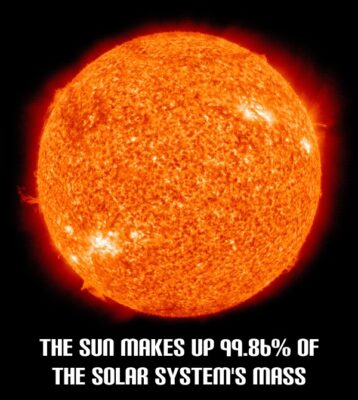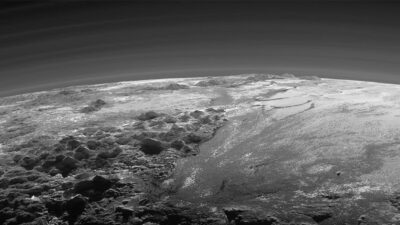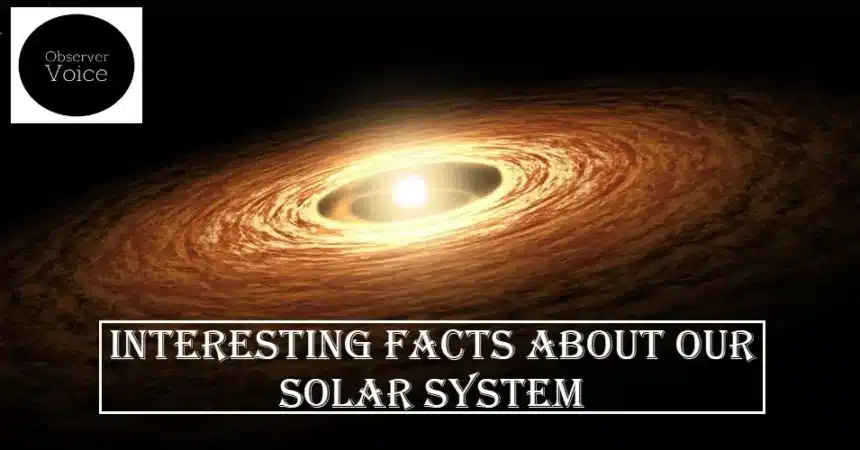Our solar system consists of planets, moons, asteroids, comets, dust, and gas that orbit our local star, the sun. Mercury, Venus, Earth, and Mars are among the rocky inner planets; Jupiter and Saturn are gas giants, and Uranus and Neptune are ice giants.
The asteroid belt sits between Mars and Jupiter, while beyond Neptune are small icy bodies such as Pluto and comets. Our good old Solar System is a bizarre place, what with all its out-of-this-world phenomena that we humans haven’t managed to explain yet. There are rumors that a gigantic, undiscovered planet is hiding behind Neptune, Volcanoes on Pluto spew ice, and a colossal canyon on Mars can accommodate the whole US territory and most of Cleveland. So, in this article, we will get to know some interesting facts about Our Solar System.
- The Solar System is 4.6 billion years old. It is a Senior Solar System. Scientists came to this conclusion after they studied the oldest material, they managed to get a hold of and that is a meteorite.
- In order to leave the Solar System, one should have to travel 11 billion miles away from Earth.
- Pluto used to be a planet but was stripped of this title in 2006. Later, it was reclassified as a dwarf planet. But the most unexpected fact about this celestial body is that its diameter is smaller than that of the US. The greatest distance across the country US (from Maine to Northern California) is about 2,800 miles. And for Pluto, it’s only 1,473 miles across.
- Like Venus, Uranus rotates in the opposite direction as most other planets. And unlike any other planet, Uranus rotates on its side, and astronomers have no idea why the planet has chosen such an unusual position.
- Our Sun is insanely massive. About 99.86% of all the mass in the Solar System is the mass of the Sun in particular, the hydrogen and helium from which it’s made up of. The remaining 0.14% is mostly the mass of the Solar System’s eight planets.

- The only asteroid belt astronomers know about is located between Mars and Jupiter. There are thousands of asteroids in this region, but they’re so widely spaced that the chance of collision is next to impossible.
- Behind the orbit of Neptune lies the mysterious Kuiper Belt, filled with massive icy objects. The most curious thing about this space formation, though, is that scientists can’t explain the pattern of its movement. The only explanation they have is that Neptune might be hiding a ginormous planet from our sight. This hypothetical planet has already got the name Planet Nine, and all we have to do is wait until its existence is confirmed.
- The volume of methane on Mars keeps wavering, and scientists just can’t figure out where it might be coming from. Methane gas is a by-product of natural processes, such as volcanic activity and cows.
- Volcanoes on Earth are as different from those on Pluto as fire and ice. On Earth, volcanoes spill lava from it while the volcanoes on Pluto spill ice. When frozen water expands, this enormous pressure builds up until it erupts. In the process, a new cryovolcano gets formed.

- One of Saturn’s moons ‘Lapetus’ has a unique color. It is two-toned. One of its hemispheres is light, and the other is dark. Scientists haven’t figured out this mystery yet.
- The atmosphere on Pluto has more than 20 layers, and all of them are super cold and very condensed. And it rises way higher above the surface of the dwarf planet.
- The Sun’s atmosphere stretches far beyond its visible surface. And our planet is right within its reach. In fact, it’s the gusts of solar wind that create the breath-taking phenomenon known as the Northern and Southern lights.
- The ocean on Jupiter is larger than any other on the rest of the Solar System’s planets. And the interesting fact is that the ocean is not water. This mesmerizing thing consists of metallic hydrogen, and its depth is a staggering 25,000miles, which is almost the same as the circumference of the Earth.
- The Planet Venus is insanely windy. Its upper winds blow 50 times faster than the planet rotates. These fierce winds never stop and can even get stronger with time. It is very difficult to even Stand on Venus.
- The Sun’s atmosphere is hotter than the surface of the star. While on the surface, the temperatures reach 10,000 degrees F, the upper atmosphere heats up to millions of degrees. Scientists suspect that explosive bursts of heat from the sun might have something to do with this unique phenomenon.
- People came to know about Saturn’s beautiful rings in the 1600s. But recently, it has become apparent that Saturn isn’t the only ringed planet. All the giant gas planets: Uranus, Neptune, and Jupiter, have rings of their own, but they’re thin and almost impossible to see. Planets including Mars, Venus, and Earth are made of rocky materials and have no rings.
Read More: How do Solar panels work?
- Our Solar System isn’t the only one in the Milky Way Galaxy. Far from it, the galaxy we live in houses about 100 billion solar systems. And that’s just our galaxy alone. So, think about how many Solar Systems are there in the Universe.
- Most of the Meteorites found in the Sahara Desert, Antarctica, and other places on our planet have a Martian origin.
- Since Mercury is the closest planet to the Sun, many people simply assume that it’s also the hottest. And that’s where they get it wrong because Venus, which is about 30 million miles further from the Sun than Mercury, is way hotter than Mercury. The reason is that Venus has an incredibly thick atmosphere, which is 100 times denser than the one we have on Earth. On top of that, this atmosphere consists almost entirely of carbon dioxide, also known as a greenhouse gas. These factors make the temperatures on the planet rise to a staggering 875 degrees F, which is hot enough to melt lead. As for Mercury, its maximum temperatures reach only 800 degrees F.
- The Earth is not only a tectonically active planet in the Solar System. Astronomers have spotted some landforms looking like cliffs on Mercury. If it’s so, the tectonic activity could explain the rapid shrinking of the planet.
- The most enormous volcano in the whole Solar System is on Mars. The size of this monster is almost as great as the state of Arizona, and its height is as big as that of Mount Everest. The reason behind this gigantic Volcano is that there’s much less gravity on Mars in comparison with our planet.
- The valley called ‘Valles Marineris’ on Mars is more than 10 times larger than Earth’s Grand Canyon. And it’s another thing that puzzles astronomers, after all, Mars isn’t a planet with active plate tectonics.
- On the surface of Jupiter, there’s a weird region that’s called the Great Red Spot. Recently, astronomers have concluded that this spot is actually a storm that’s been raging on the planet for centuries. But some 20 years ago, scientists noticed that the red region started to shrink. Nowadays, it’s just half the size it used to be. And still, the spot is one and a half times bigger than Earth.

